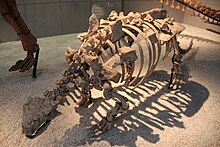Zhejiangosaurus
| Zhejiangosaurus Temporal range: Late Cretaceous,
| |
|---|---|

| |
| Zhejiangosaurus lishuiensis on display at the Zhejiang Museum of Natural History | |
| Scientific classification | |
| Domain: | Eukaryota |
| Kingdom: | Animalia |
| Phylum: | Chordata |
| Clade: | Dinosauria |
| Clade: | †Ornithischia |
| Clade: | †Thyreophora |
| Clade: | †Ankylosauria |
| Clade: | †Euankylosauria |
| Genus: | †Zhejiangosaurus Lü et al., 2007 |
| Species: | †Z. lishuiensis
|
| Binomial name | |
| †Zhejiangosaurus lishuiensis Lü et al., 2007
| |
Zhejiangosaurus (meaning "Zhejiang lizard") is an extinct genus of ankylosaurian dinosaur from the Upper Cretaceous (Cenomanian stage) of Zhejiang, eastern China. It was first named by a group of Chinese authors Lü Junchang, Jin Xingsheng, Sheng Yiming and Li Yihong in 2007 and the type species is Zhejiangosaurus lishuiensis ("from Lishui", where the fossil was found).[1] It has no diagnostic features, and thus is a nomen dubium.[2]
Description
[edit]Zhejiangosaurus could grow up to 4.5 m (17 ft) in length and was 1.4 metric tons in weight.[3]
Material
[edit]Material for Zhejiangosaurus consists of the holotype, ZNHM M8718, a partial skeleton which has preserved a sacrum with eight vertebrae, a complete right ilium and partial left ilium, a complete right pubis, the proximal end of the right ischium, two complete hindlimbs, fourteen caudal vertebrae, and some unidentified bones. These remains come from Liancheng, in the Chinese administrative unit of Lishui on the province of Zhejiang and they were collected from the Cenomanian-age Chaochuan Formation.[1]
Systematics
[edit]On the species description, Lü et al. (2007) found Zhejiangosaurus to belong to the ankylosaurian family Nodosauridae.[1][4]
Zhejiangosaurus in a cladogram after Pond et al. (2023):[5]
See also
[edit]References
[edit]- ^ a b c Lü Junchang; JIN Xingsheng; SHENG Yiming; LI Yihong; WANG Guoping; Yoichi AZUMA (2007). "New nodosaurid dinosaur from the Late Cretaceous of Lishui, Zhejiang Province, China". Acta Geologica Sinica. 81 (3) (English ed.): 344–350. Bibcode:2007AcGlS..81..344L. doi:10.1111/j.1755-6724.2007.tb00958.x. S2CID 128548615.
- ^ Arbour, Victoria M.; Currie, Philip J. (2015). "Systematics, phylogeny and palaeobiogeography of the ankylosaurid dinosaurs". Journal of Systematic Palaeontology. 14 (5): 1. Bibcode:2016JSPal..14..385A. doi:10.1080/14772019.2015.1059985. S2CID 214625754.
- ^ Paul, Gregory S. (25 October 2016). The Princeton field guide to dinosaurs (2nd ed.). Princeton, N.J. p. 253. ISBN 978-1-4008-8314-1. OCLC 954055249.
{{cite book}}: CS1 maint: location missing publisher (link) - ^ Richard S. Thompson; Jolyon C. Parish; Susannah C. R. Maidment; Paul M. Barrett (2012) [Published online: 30 June 2011]. "Phylogeny of the ankylosaurian dinosaurs (Ornithischia: Thyreophora)". Journal of Systematic Palaeontology. 10 (2): 301–312. Bibcode:2012JSPal..10..301T. doi:10.1080/14772019.2011.569091. S2CID 86002282.
- ^ Pond, Stuart; Strachan, Sarah-Jane; Raven, Thomas J.; Simpson, Martin I.; Morgan, Kirsty; Maidment, Susannah C. R. (2023-01-01). "Vectipelta barretti, a new ankylosaurian dinosaur from the Lower Cretaceous Wessex Formation of the Isle of Wight, UK". Journal of Systematic Palaeontology. 21 (1). Bibcode:2023JSPal..2110577P. doi:10.1080/14772019.2023.2210577. ISSN 1477-2019.

